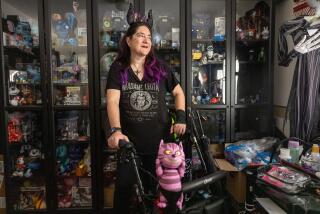Op-Ed: Amid COVID-19, the Americans With Disabilities Act turns 30. It needs to be updated
In the days of COVID-19-induced self-quarantine, Americans rely on apps and websites to work, buy food, attend school, consume news and entertainment, and communicate with one other. The internet has largely displaced brick-and-mortar spaces as the main forum for public life.
Meanwhile, amid widespread layoffs and telecommuting, businesses have increased their reliance on artificial intelligence to perform tasks previously conducted by humans, including monitoring employees and deciding who to hire and fire. These algorithms can target people with disabilities. However, the Americans With Disabilities Act, which turns 30 on Sunday, rarely applies to either type of digital discrimination. Congress must update this aging law to reflect the threats people with disabilities face in contemporary society.
The ADA’s drafters, working in 1990 when the internet was in its infancy, could not have foreseen the need to address online interactions as they sought to end rampant disability discrimination. When they wrote that disability discrimination is prohibited in “places of public accommodation,” they listed only physical spaces like schools, restaurants and movie theaters. Consequently, most courts don’t consider online businesses such as Amazon and Netflix places of public accommodation — and they need not comply with the ADA.
As a result, disabled Americans are unable to use many apps and websites. The physical barriers that once restricted access for people with disabilities have been replaced by computer code. The COVID-19 pandemic highlights this problem and heightens the stakes.
During emergencies requiring people to shelter in place, disabled people may be denied access to goods and services that other Americans rely on to survive. They may be unable to order food if delivery apps lack accessibility features such as text-to-speech capability, video captions, and compatibility with alternate input devices. Because of widespread adoption of video-conferencing software, disabled students and employees may be unable to attend school or work if platforms like Skype and Zoom are inaccessible.
A handful of federal courts have considered whether online platforms are places of public accommodation. In the 2015 case National Federation of the Blind vs. Scribd, the U.S. District Court of Vermont held that a document-sharing website fit the description and must be accessible. The court reasoned that it shouldn’t matter whether people use brick-and-mortar businesses or their online equivalents; the ADA demands equal access. However, in Cullen vs. Netflix, also from 2015, the U.S. District Court of Northern California disagreed, arguing that because Netflix’s platform is unconnected to a physical location, it is not a place of public accommodation and need not comply.
In Domino’s Pizza vs. Robles, the plaintiff, who was blind, sued Domino’s because he couldn’t order food from its website. Last year, the Supreme Court declined to hear the case, sending it back to an appellate court. But that was before COVID-19 highlighted the need for a national approach to ensuring equality online. Congress should now amend the ADA to classify online businesses as places of public accommodation, requiring them to adopt accessibility tools.
Critics might argue that mandating web accessibility is overly burdensome, especially for small businesses. But it’s not necessarily difficult or expensive. An organization called the Web Accessibility Initiative provides open-source tools that developers can incorporate into their websites for free.
Despite the ease of implementing accessibility tools, most apps and websites have failed to adopt them. That’s why mandating their use is necessary to achieve widespread accessibility. Amending the definition of “places of public accommodation” would be a good start.
However, other sections of the ADA must also be updated. Some forms of information-age discrimination cannot be solved with a place-based approach, which requires drawing analogies between each source of discrimination and a physical space. The latest variety is algorithmic disability discrimination, where AI infers disabilities and discriminates against people because of them. Algorithms often have no place-based equivalents. But algorithmic disability discrimination is increasingly common online, at work and in schools — and the ADA provides inadequate protection.
Title I of the ADA prohibits disability discrimination in hiring, job training and performance evaluation. These facets of employment are increasingly governed by AI, especially during the pandemic. Employers use electronic surveillance to monitor people working from home because of COVID-19. Due to the pandemic’s economic impact, millions of Americans have been laid off. When they seek new jobs, they will apply online, and AI will screen their applications. Some companies have replaced in-person interviews with online versions conducted by AI-powered avatars.
But like apps and websites, these tools are rarely designed with disabled people in mind. Moreover, research shows that AI can be just as biased against people with disabilities as human interviewers. Thirty years after the ADA was adopted, software is replacing people as agents of employment discrimination.
Currently, the ADA burdens employees with reporting and proving instances of disability discrimination. But algorithmic discrimination occurs in the shadows. Even if employees suspect discrimination, it is difficult to prove because employers control access to the technology and all the data. To promote equal treatment of disabled employees in the information age, Congress should amend the ADA to place the burden on employers to prevent disability discrimination.
Disabled Americans deserve equal treatment from all businesses — whether the company is physical or virtual, with humans or machines.
Mason Marks is an assistant professor of law at Gonzaga University and a fellow in the ethics of technological and biomedical innovation at Harvard Law School.
More to Read
A cure for the common opinion
Get thought-provoking perspectives with our weekly newsletter.
You may occasionally receive promotional content from the Los Angeles Times.










